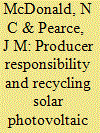| Srl | Item |
| 1 |
ID:
097276


|
|
|
|
|
| Publication |
2010.
|
| Summary/Abstract |
As the Ontario government has recognized that solar photovoltaic (PV) energy conversion is a solution to satisfying energy demands while reducing the adverse anthropogenic impacts on the global environment that compromise social welfare, it has begun to generate policy to support financial incentives for PV. This paper provides a financial analysis for investment in a 1 GW per year turnkey amorphous silicon PV manufacturing plant. The financial benefits for both the provincial and federal governments were quantified for: (i) full construction subsidy, (ii) construction subsidy and sale, (iii) partially subsidize construction, (iv) a publicly owned plant, (v) loan guarantee for construction, and (vi) an income tax holiday. Revenues for the governments are derived from: taxation (personal, corporate, and sales), sales of panels in Ontario, and saved health, environmental and economic costs associated with offsetting coal-fired electricity. Both governments enjoyed positive cash flows from these investments in less than 12 years and in many of the scenarios both governments earned well over 8% on investments from 100 s of millions to $2.4 billion. The results showed that it is in the financial best interest of both the Ontario and Canadian federal governments to implement aggressive fiscal policy to support large-scale PV manufacturing.
|
|
|
|
|
|
|
|
|
|
|
|
|
|
|
|
| 2 |
ID:
099311


|
|
|
|
|
| Publication |
2010.
|
| Summary/Abstract |
Rapid expansion of the solar photovoltaic (PV) industry is quickly causing solar to play a growing importance in the energy mix of the world. Over the full life cycle, although to a smaller degree than traditional energy sources, PV also creates solid waste. This paper examines the potential need for PV recycling policies by analyzing existing recycling protocols for the five major types of commercialized PV materials. The amount of recoverable semiconductor material and glass in a 1 m2 area solar module for the five types of cells is quantified both physically and the profit potential of recycling is determined. The cost of landfill disposal of the whole solar module, including the glass and semiconductor was also determined for each type of solar module. It was found that the economic motivation to recycle most PV modules is unfavorable without appropriate policies. Results are discussed on the need to regulate for appropriate energy and environmental policy in the PV manufacturing industry particularly for PV containing hazardous materials. The results demonstrate the need to encourage producer responsibility not only in the PV manufacturing sector but also in the entire energy industry.
|
|
|
|
|
|
|
|
|
|
|
|
|
|
|
|